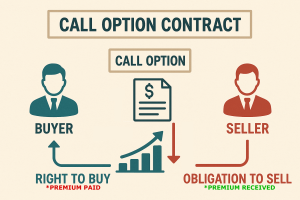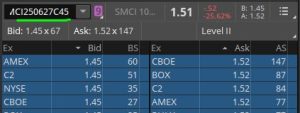 A call options contract is an agreement between two parties. The buyer of an option is purchasing the right to be able to buy 100 shares of stock at an agreed upon price on the target date. The seller is receiving a premium with the obligation to possibly have to sell 100 shares of stock to the buyer at the agreed upon price.
A call options contract is an agreement between two parties. The buyer of an option is purchasing the right to be able to buy 100 shares of stock at an agreed upon price on the target date. The seller is receiving a premium with the obligation to possibly have to sell 100 shares of stock to the buyer at the agreed upon price.
The best way to explain this in real terms is to use an example. Let us say that ACME is a company you’re interested in. They produce traps and equipment for catching coyotes.
 For the sake of this example, we’re going to take on the viewpoint that you are the person who owns the stock, but is looking to sell a CALL contract “against” your stock in order to pick up some extra cash and protect your investment a little bit against some possible price instability.
For the sake of this example, we’re going to take on the viewpoint that you are the person who owns the stock, but is looking to sell a CALL contract “against” your stock in order to pick up some extra cash and protect your investment a little bit against some possible price instability. If the price of this stock is at $40 today, it’s possible that in 4 weeks time, it could be +/- $5 and you’re a bit concerned that it may be to the lower side. So you’ve gone to the option market to see what someone might pay for an option at $45 in 4 weeks time. To your delight, you see the prices on that option are attractive to you as you’re already a bit concerned it might not get there. We’re going to use a real stock example that is at $40 today, and look at it’s call option bid-ask at $45.
 Let’s breakdown this screen shot of 20250627C45. The first 8 digits is the date June 27th 2025 then a “C” because it’s a call contract, and then 45 because the price we’re looking at is $45.
Let’s breakdown this screen shot of 20250627C45. The first 8 digits is the date June 27th 2025 then a “C” because it’s a call contract, and then 45 because the price we’re looking at is $45.
The bidders are paying $1.45 and sellers are asking $1.52. Therefore it’s logical that a price can he had for probably $1.50 on this option at this moment in time.
Now let’s do some real world calculations. If the contract is worth $1.50, we multiply that by 100 because normally an option contract is for 100 shares. Therefore each contract is going to generate $150 for the seller, with the buyer paying that cost with the hopes that the stock will be well above $45 on June 27th.
Fast forward now to June 27th. If the price of the stock is $45 or below, the seller will have 100% gain on the money originally received because there will be no need to buy it back.
The buyer on the other hand, needs the stock to be above $46.50 just to break even. Remember, the buyer paid $1.50 to buy that option, so if they’re expecting a profit, the price at the expiration must be above the stock price + the premium.
Now, a lot can happen along the way, and there may be opportunities for either the buyer or the seller to close the contract and have a profit. For example, if the price had dipped significantly after the selling date, and the seller was in a 50% profit position on the contract after only 3 days, it might be smart to consider closing the contract right then by buying it out.
On the flip side, if there was a sudden surge, then the option price will surge suddenly also, and the buyer may see this as an opportunity to take the sure money, and cash out.
Related Posts

Milestone Oct31
Milestone Oct31 40 days into this strategy, and this milestone is taking some measurements at the end of the month, October 31st. A few things

Milestone Oct17
Milestone Oct17 Here we are at day 27, almost a full month, and just completing the first milestone of this new strategy that began on
SPY versus SPLG
SPY versus SPLG Initially when I chose SPLG as the instrument of choice it was because the share price is only in the $70s, and